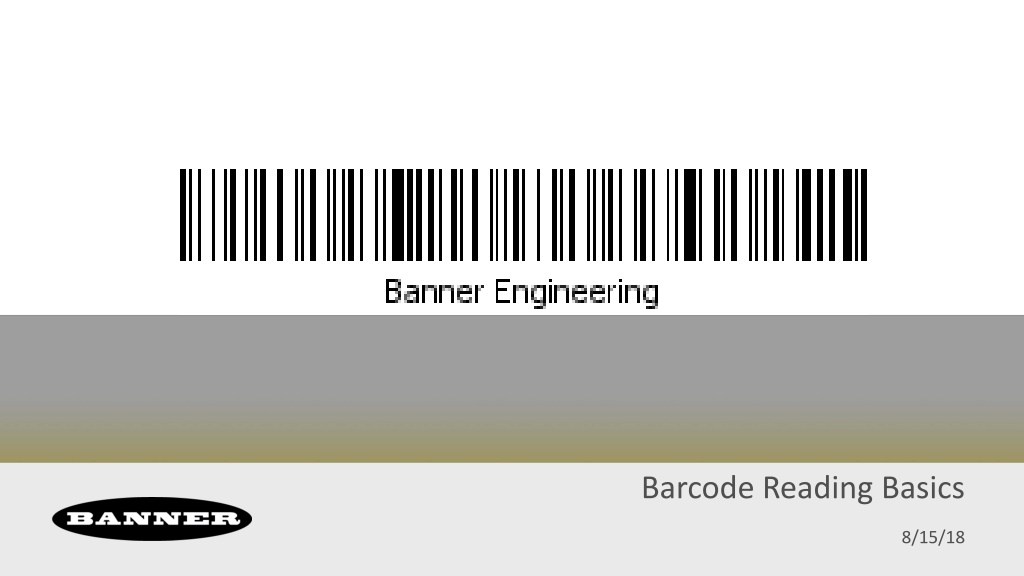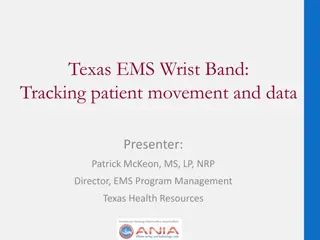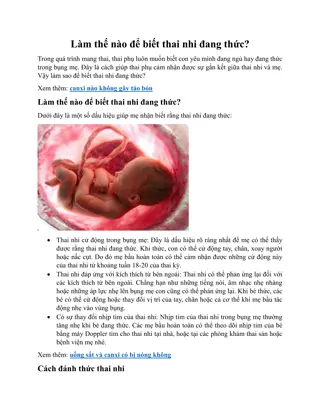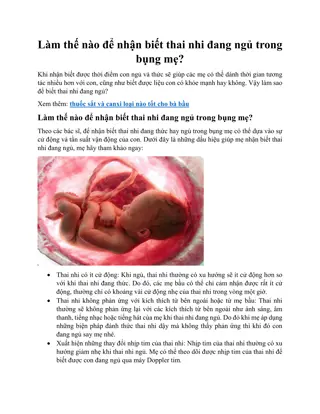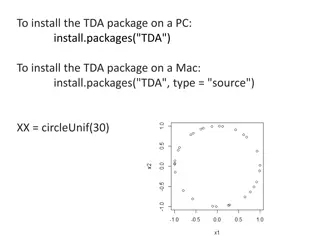The Evolution of Barcodes: A Comprehensive Overview
Explore the history, functionality, and diverse applications of barcodes, from their inception in 1949 to their modern-day role in industries like retail, healthcare, and government. Discover how barcodes revolutionized tracking, authentication, and inventory management, and learn about the emergence of QR codes and advanced traceability technologies for combating counterfeiting. Uncover the significant impact of barcodes on global supply chains and the potential they hold for enhancing efficiency and security across various sectors.
Download Presentation

Please find below an Image/Link to download the presentation.
The content on the website is provided AS IS for your information and personal use only. It may not be sold, licensed, or shared on other websites without obtaining consent from the author.If you encounter any issues during the download, it is possible that the publisher has removed the file from their server.
You are allowed to download the files provided on this website for personal or commercial use, subject to the condition that they are used lawfully. All files are the property of their respective owners.
The content on the website is provided AS IS for your information and personal use only. It may not be sold, licensed, or shared on other websites without obtaining consent from the author.
E N D
Presentation Transcript
Barcode Reading Basics 8/15/18
What Is a Barcode? A way to print data that is designed to be easy for machines to read. Reading the data just requires a machine to analyze rows of dark bars and light spaces between them and distinguish the widths of the bars and spaces. There are many different ways to encode data in a barcode symbol, we call these different strategies barcode symbologies . Thick Bars Pharmacode, for example is a very simple symbology with only 2 different bar widths to encode all the data with. Thick bars are 1 s, thin bars are 0 s. 1010= Thin Bars
Barcode Origins In 1949, the 1st patent is filed by 2 friends and Drexel alumni, Silver and Woodland. In 1966, the National Association of Food Chains met to discuss the possibility of automated checkout in grocery stores. Tech companies submitted proposals, IBM s was accepted. In 1974, the first UPC was scanned at checkout
Barcode Origins in Industry Large scale industrial use started in 1981, when the US DoD Started LOGMARS, (LOGistics application of automated Marking And Reading Symbols) Military Standard MIL-STD-1189B, to mark every product they bought, using symbology Code 39.
QR code and Mobile Use Now there are many new uses, like accessing web pages by scanning a QR code with a phone.
Traceability: Anti-Counterfeit ePedigree Requirements Counterfeit drugs 10% Worldwide, 1% in USA Need Track & Trace Technologies Drug Quality and Security Act (2013) Serialization on each item of sale By RFID or Barcode
Government - Military UID (Unique IDentification) Military Standard MIL-STD-130L US Dept of Defense project to mark (with a Data Matrix symbol) every component and/or subassembly costing over $5000
Barcode Family Types LINEAR or 1D First type invented. All lines are parallel so the code can be read along one line alone, such as with a laser line scanner POSTAL Mostly 1-Dimensional, except that lines are different heights instead of widths. Designed for printing on envelopes for mail sorting. 2D and STACKED A more complex design designed to take advantage of capabilities of modern reading devices like cameras and allow for better density, redundancy and error checking.
Standard Barcode Symbologies 1D: Codabar Code 39 Code 128 I 2 of 5 EAN 13 EAN 8 UPC Code 93 MSI Pharmacode Postal: Postnet IMB Australia Post Royal Mail 4 State Japan Post PLANET Swedish Post 2D and Stacked: ECC-200 DataMatrix PDF-417 QR MicroQR MAXICODE Aztec Code GS1 Databar
Where Used? LINEAR Codabar (aka USD-4, 2 of 7 Code, NW-7 in Japan) c.1972 [discrete, self-checking, 16 characters] Used in blood banks, cotton industry, libraries, photo labs, air parcel express, other information processing applications. Code 39 (public domain) c. 1975 [discrete, optional check-sum, 43 characters] Most common non-UPC (i.e. non-retail) code. Users include Department of Defense (LOGMARS- Logistics Applications of Automated Marking and Reading Symbols), automotive industry (AIAG- Automotive Industry Action Group), general industry, health industry (HIBCC- Health Industry Business Communications Council).
Where Used? LINEAR (Continued) Code 128 (aka UCC-128) (public domain) c.1981 [continuous, check-sum, 128 characters] Most compact linear code. Common in applications where a large amount of data needs to be encoded. Used in retail distribution, serialized carton tracking ( use before dates encoded), general industrial, inventory control, retail container marking. Some of the types of data that can be encoded: traceability dates & numbers, measurements, quantities, transaction references, and location numbers.
Where Used? LINEAR (Continued) Interleaved 2 of 5 (aka I 2 of 5)- (public domain) c.1972 [continuous, optional check-sum, numeric] Used mostly in corrugated carton labeling for distribution industry, warehousing, product/container identification, general industrial, automotive.
Where Used? LINEAR (Continued) EAN-13 (European Article Numbering Code-13) (public domain) UPC c.1973; EAN c.1976 [discrete, check-sum, numeric] Like an international UPC system. Includes UPC-A format, also includes JAN (Japanese Article Numbering) format. Used mainly for retail products worldwide. EAN-8 (public domain) c. 1976 [discrete, check-sum, numeric] A shorter version of EAN-13 developed for smaller packages. Not equivalent to UPC-E, the US shortened version of the UPC-A barcode.
Where Used? TWO DIMENSIONAL Data Matrix - (public domain) c.1990 Mostly used to label integrated circuits and printed circuit boards. Industries include automotive, aerospace, electronics, semiconductor and medical devices. Stores 1.555 kb of data. 2-D symbols like the Data Matrix are a method of encoding a large amount of information in a small space. By using sophisticated error checking and correction schemes up to 27% of the symbol can be damaged or missing and the data is still readable PDF417- (public domain) c.1991 Uses include fingerprints and photographs on driver s license, hazardous material labeling, technical or calibration data stuck directly on side of equipment. Stores 1.1kb of data.
Linear Barcodes - Terminology Min Bar Width, AKA X dimension, Min Element Width, resolution, or barcode size, is the most important spec for a barcode, to make sure it can be read when planning a reading application. Min Bar Width Space Bar Common X dimensions are between 0.006 -0.020 Height Quiet Zones should be at least 10 times the width of the Min Bar Width Quiet Zone (no print allowed)
Data Matrix Symbol - Terminology Common Element or cell sizes are between 0.005 -0.030 . Element (cell) Size (ex. 14x14) Quiet Zone (Size Varies, typically 2 elements)
2-D Barcodes - Data Matrix The most popular 2-D code in use today is the Data Matrix, first patented in 1990 (since placed in the public domain) Timing Bars - A broken border along the other two sides defines the data density. (Example is 14 x 14) A Data Matrix is a two dimensional array made up of individual elements or cells. Locator Bars - An L-shaped solid border brackets two sides of the symbol and defines the symbol s location.
Data Matrix Data Matrix Symbols can be: Rectangular Square Inverse Polarity (white on black) Mirrored (flipped vertically) Most Popular format called ECC200 Always even number of cells All these matrices say: Banner Engineering BCR
2-D Barcodes- Data Matrix The symbols can encode up to 3116 numbers or 2335 letters! This example is the Gettysburg Address: The Gettysburg Address Gettysburg, Pennsylvania November 19, 1863 Four score and seven years ago our fathers brought forth on this continent, a new nation, conceived in Liberty, and dedicated to the proposition that all men are created equal. Now we are engaged in a great civil war, testing whether that nation, or any nation so conceived and so dedicated, can long endure. We are met on a great battle-field of that war. We have come to dedicate a portion of that field, as a final resting place for those who here gave their lives that that nation might live. It is altogether fitting and proper that we should do this. But, in a larger sense, we can not dedicate -- we can not consecrate -- we can not hallow -- this ground. The brave men, living and dead, who struggled here, have consecrated it, far above our poor power to add or detract. The world will little note, nor long remember what we say here, but it can never forget what they did here. It is for us the living, rather, to be dedicated here to the unfinished work which they who fought here have thus far so nobly advanced. It is rather for us to be here dedicated to the great task remaining before us -- that from these honored dead we take increased devotion to that cause for which they gave the last full measure of devotion -- that we here highly resolve that these dead shall not have died in vain -- that this nation, under God, shall have a new birth of freedom -- and that government of the people, by the people, for the people, shall not perish from the earth.
Barcode Reading Technologies Laser (older technology) Imager-based (newer technology) Takes a digital picture of a 2D area Advantages: Spins a mirror wheel to generate a laser line to illuminate barcodes Advantages: Omnidirectional Cost/Performance Value Barcode Placement Flexibility No Moving Parts 2D Code reading Photo Via: http://www.photonics.ld-didactic.de
